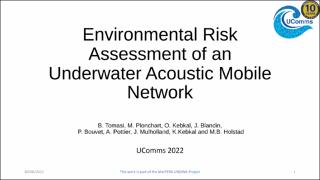| dc.description.abstract | Underwater vehicles make inspections and surveillance safer and with a lower carbon footprint than ship-based operations. However, to effectively operate them, they need robust positioning and communication systems. One solution is to use multi-modal communications, that can operate at very short (centimeters), medium (meters), and long distances (hundreds of meters). In this paper, we describe a multi-modal mobile network, whereby a simple acoustic communication and positioning protocol is used to send network control messages and positioning signals, optical point-to-point links may be used to transfer larger data files, and magnetic induction data and power transfer is used to recharge the drone and offload the data from the drone to the benthic station. In this context, we then quantify the sound exposure level and the impact radius reduction derived from using multi-modal underwater communications with respect to full acoustic approach in underwater mobile networks. | en_US |
